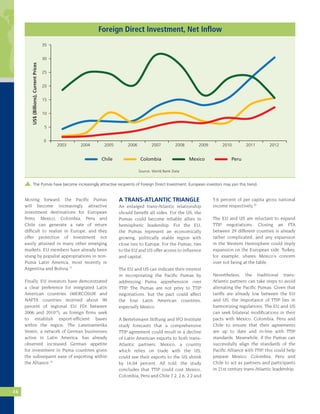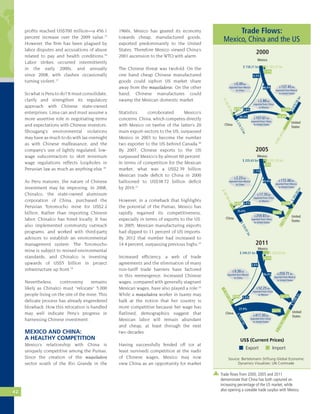The document discusses the economic emergence of Mexico, Colombia, Peru, and Chile, collectively referred to as the 'Pacific Pumas', highlighting their commitment to sound macroeconomic policies and global integration. Their successes position them as potential regional leaders in Latin America and strategic partners for the U.S., Europe, and Asia. While facing ongoing challenges such as violence and inequality, the Pacific Pumas are on a promising path to forge a new model for emerging markets.
































![The Pacific Pumas are emerging as
leaders and trend setters in Latin
America. United through the Pacific
Alliance, they are large enough, and
have enough gravitational pull, to
attract smaller regional countries into
the fold. Mexico, Colombia, Peru and
Chile have established their model as an
alternative to the more statist ALBA bloc
or the more protectionist MERCOSUR
economic pact.
The Pumas have stressed that their
effort is meant to facilitate regional
integration—not to reinforce continental
divisions. But an emerging consensus
holds that the Pacific Alliance is a
conscious effort to escape from beneath
the looming shadow of Brazil, to promote
regional integration that is more trade
friendly than MERCOSUR, and to counter
any residual ALBA influence.
The Economist has heralded a “continental
divide”, writing, “The region is falling
behind two alternative blocs: the market-
led Pacific Alliance and the more statist
MERCOSUR.”1
The venerable Latin
Americanist Andres Oppenheimer
similarly concluded that “the economic
divide between Latin America’s Pacific
and Atlantic blocs [has become]
increasingly visible.”2
Grumblings from
the 2013 MERCOSUR Social Summit in
Montevideo suggested that elements
of the Atlantic bloc themselves had
succumbed to this interpretation.
To an extent, they are accurate. Puma
policymakers believe that Brazil’s large
population offers an internal growth
motor that is underdeveloped in Mexico
and Colombia, and difficult to fathom
in Peru or Chile.3
Thus, Brazil can
afford (or at least believes it can afford)
protectionist trade policy. Given Brazil’s
weighty influence in MERCOSUR, not
to mention the influence of Argentina
and Venezuela, the Pumas do not
wish to align with an increasingly
defensive bloc.4
But here is the catch: The Pacific Pumas
would greatly benefit from a unified
Latin America, and in many cases,
basic economic theory suggests they
would be perfect partners. In fact, the
Pacific Pumas have tried to deepen
trade relations between the two “sides”.
However, they have directly experienced
the unexpected and often unnecessary
shocks associated with conducting
business with Latin American countries
that do not share their free market, low
tariff, non-interventionist strategy. The
following three examples demonstrate
these risks.
• Chilean Energy Insecurity
Chile, a net importer of coal, oil and gas
has long faced energy insecurity. In the
US, a negative energy shock may lead to
higher prices at the pump. But in Chile,
when Argentine gas supplies dried up in
September 2011, more than 50 percent
of the nation experienced power outages
that “paralyzed the country’s copper
mines and brought Santiago grinding to
a halt”.5
Chile cannot satisfy spiking natural gas
demand with domestic supply.6
At best,
Magallanes, a gas producing region
in Chile’s deep south, can support 40
percent of Chile’s demand for liquid
petroleum gas, mostly limited to the
south of the country. Former President
Sebastián Piñera’s support for building
five hydroelectric plants in pristine
Patagonia generated more hot air
than gas: Public backlash held Piñera’s
approval rating in the 30s and the project
itself is now four years behind schedule.
Thus when a natural gas bonanza
unfolded in neighboring Bolivia and
Argentina,7
Chile appeared perfectly
positioned to benefit: Bolivia could
supply Chile’s copper-mining north,
while Argentine pipelines would feed the
populous Chilean heartland.
Unfortunately, it never worked out that
way. Santiago has been dogged by the
vicissitudes of Argentine energy policy,
where populism has meant whimsical
rules of the game, meddlesome
macroeconomic policies and disputed
contracts.8
These issues have undermined
Chilean trust in the availability of its
neighbor’s gas exports.9
Meanwhile Chile has been unable to
reach a gas export deal with Bolivia,
where resource protectionism and
hostility towards Santiago have
defined President Evo Morales’ rise,
and he has proven reluctant to tinker
with this strategy.10
Morales has
stubbornly demanded coastal territory
in exchange for a pipeline to Chile,
and La Paz has exhausted diplomatic
capital petitioning territorial redress in
international courts.11
Unable to rely on its neighbors, Chile
has been forced to find expensive,
intercontinental sources of energy.
Santiago invested in expensive liquefied
natural gas infrastructure and it imports
supercooled gas from Trinidad and
Tobago and Equatorial Guinea—a
strategy expected to expand during a
second Bachelet presidency.12
• Colombia Venezuela:
The Politics of Trade
For Colombia, anxious to enlarge a
manufacturing export portfolio, proximity
to Venezuela offers opportunity.
With Venezuelan production geared
Global Opportunities | Latin America Divided?
Latin America Divided?6
31](https://image.slidesharecdn.com/zu2vwvfms1yg1mkg4i7o-signature-c02a4bf68951469eca881fabf47280747e1a0c2cdcfa65684732300bf664d0fb-poli-150319175805-conversion-gate01/85/The-Pacific-Pumas-An-Emerging-Model-for-Emerging-Markets-33-320.jpg)















![10
Colombia has not suffered the severe macro fluctuations and economic collapses endemic to Latin America and much of the developing world in recent decades. It was the only major Latin
American country not forced to restructure international obligations during the 1980s debt crisis that racked the region. Colombia emerged unscathed by the tequila crisis of the mid-90s and
bounced back quickly from a one-year downturn during the East Asian crisis of the late-1990s. It has grown right through the great global recession. See: See Jennifer Holmes, Sheila Amin Gutiérrez
de Piñeres and Kevin Curtin. Guns, Drugs Development in Colombia (Texas: University of Texas Press, 2009); and James Robinson. “A Normal Latin American Country? A Perspective on Colombian
Development.” November 21, 2005. Available online at http://scholar.harvard.edu/files/jrobinson/files/jr_normalcountry.pdf.
11
“The Humanitarian Crisis in Colombia Caused by the Armed Conflict.” International Organizations Position Paper: Colombia, 2011. Available online at
http://www.internal-displacement.org/8025708F004CE90B/(httpDocuments)/7C6B5E44F9918459C125797600398E72/$file/colombia-humanitarian-crisis-17nov2011-eng.pdf.
12
Acemoglu and Robinson, 277 – 283.
13
Inequality remains high in Colombia, and even people who have suffered directly from FARC violence can be sympathetic to the original ideology.
14
¿Alguien espió a los negociadores de La Habana? Semana, Februrary 3 2014. Available online at http://www.semana.com/nacion/articulo/alguien-espio-los-negociadores-de-la-habana/376076-3
15
Petro y Cepeda son amenazados por las Águilas Negras. Semana, February 4, 2014. Available online at
http://www.semana.com/nacion/articulo/cepeda-petro-son-amenazados-por-aguilas-negras/376125-3.
16
Peter Siavelis. “Chile: The End of the Unfinished Transition.” In Jorge Domínguez and Michael Shifter (eds.)Constructing Democratic Governance in Latin America, 3rd Edition (Baltimore: The Johns Hopkins
University Press, 2008), 191 – 196.
17
Reforms in 1989 chipped away at unelected influences over Chilean democracy. More far-reaching reforms in 2005 reigned in executive powers while simultaneously restoring civilian oversight of the
military. Source: Claudia Heiss. “Bachelet Appoints Group to Study New Constitution for Chile.” Int’l J. Const. L. Blog, May 1, 2013. Available online at
http://www.iconnectblog.com/2013/05/bachelet-appoints-group-to-study-new-constitution-for-chile.
18
According to Siavelis, the education law “transferred the authority for public education from the central government to the municipalities, creating huge gaps between rich and poor areas
(Siavelis, 202).”
19
For OECD corporate tax income averages, see “OECD Corporate Income Tax Rates, 1981-2012.” Tax Foundation, June 29, 2012. Available online at
http://taxfoundation.org/article/oecd-corporate-income-tax-rates-1981-2012.
20
Francisco Peregil. “Michelle Bachelet, presidenta electa de Chile tras una amplia victoria.” El Pais, December 16, 2013. Available online at
http://internacional.elpais.com/internacional/2013/12/15/actualidad/1387145955_299083.html.
21
Kristen Sehnbruch and Peter Siavelis. “Why Victory for Bachelet in Chile is undeniable but bittersweet.” The Washington Post (November 25, 2013). Available online at
http://www.washingtonpost.com/blogs/monkey-cage/wp/2013/11/25/why-victory-for-bachelet-in-chile-is-undeniable-but-bittersweet/.
22
Alex Kaiser. “Is This the End of the Chilean Economic Miracle?” Forbes, October 28, 2013. Available online at
http://www.forbes.com/sites/realspin/2013/10/28/is-this-the-end-of-the-chilean-economic-miracle/.
23
See Cornelius Fleischhaker, “Peru: The Growing Pains of a Puma Cub,” No Se Mancha, September 29, 2013. Available online at http://semancha.com/2013/09/29/peru-puma-cub/.
24
“President Humala: Peru’s foreign policy based on dignity and honor.” Andina, September 24, 2011. Available online at
http://www.andina.com.pe/Ingles/noticia-president-humala-perus-foreign-policy-based-on-dignity-and-honor-379191.aspx.
25
In terms of Peruvian parties, Alberto Fujimori’s 1990 Cambio 90, Alejandro Toledo’s 2001 Peru Posible and Ollanta Humala’s 2011 Gana Peru parties were all built by the presidential candidates
themselves. Alan Garcia ran on the populist APRA ticket in 2006.
26
See “Humala Humbled: A lonelier president faces protests.” The Economist, August 3, 2013. Available online at
http://www.economist.com/news/americas/21582580-lonelier-president-faces-protests-humala-humbled?zid=309ah=80dcf288b8561b012f603b9fd9577f0e.
Chapter 4
1
Unweighted averages. Source: International Monetary Fund Data
2
Trade is a sensitive subject in Latin America where exposure to global tailwinds has led to periods of dizzying booms and busts. Many 19th century patriots were inspired to take up arms against
colonial Spanish rule to liberate the new world from restrictive trade policies. A subsequent era of trade climaxed between 1870 and 1914 when European demand for Latin American raw materials
coincided with a boom in emerging market investment: During this period, Latin America outgrew the US in both GDP and per-capita GDP. See Francisco Gonzalez, Creative Destruction: Economic Crisis and
Democracy in Latin America (Baltimore: The Johns Hopkins University Press, 2012), 47.
This golden age of free trade dissolved during World War I. International dynamics would only worsen with the onset of the Great Depression. Caught in macroeconomic tides beyond its control, Latin
American economists questioned the efficacy of export-led growth. These sentiments culminated in one of the region’s notable contributions to economic philosophy, dependency theory, which held
that free trade pigeonholed Latin America into exporting raw materials in exchange for ever-more expensive manufactured goods.
The region transitioned to an inward-looking development model, raising prohibitive tariffs against imports while nurturing domestic manufacturers. This import-substitution industrialization (ISI) of
the 1950, ‘60s and ‘70s distorted currencies, overvaluing exports and undervaluing imports; two factors that helped trigger the sovereign debt crises of the 1980s.
Latin America underwent shotgun liberalization in the 1980s and 1990s under the guidance of the World Bank, the International Monetary Fund, and the US Treasury. Reformers often lacked a
mandate: The governments that lowered trade barriers in Mexico, Peru and Chile had dubious democratic credentials, at best.
Subsequent neoliberal politicians struggled at the ballot box in the 2000s, and many larger Latin American countries (but not the Pumas) began to unwind neoliberal reforms as part of the region’s
so-called “pink tide.”
3
Shaping the Future of Asia and the Pacific Latin-America and the Caribbean Relationship. (Washington: Inter-American Development Bank, 2012).
4
Inter-American Development Bank (2012), 50.
5
Ibid.
6
Bertelsmann Foundation, Global Economic Dynamics Visualizer, 2013.
7
“China becomes Peru’s main trade partner and a leading investor.” MercoPress, September 23, 2011. Available online at
http://en.mercopress.com/2011/11/30/china-becomes-peru-s-main-trade-partner-and-a-leading-investor.
8
“NAFTA at 20: Deeper, Better, NAFTA.” The Economist, January 4, 2014. Available online at
http://www.economist.com/news/leaders/21592612-north-americas-trade-deal-has-delivered-real-benefits-job-not-done-deeper-better.
9
Source: IQOM Commercial Intelligence Data
10
An unwritten rule limits TPP participants to members of the Asia-Pacific Economic Cooperation (APEC), of which Colombia is not a member. A moratorium on APEC membership has prevented any
new members from joining since 1998. (See: Barbara Kotschwar. “The Pacific Alliance, the TPP, and the RCEP: What does it all mean?” The Peterson Institute, 2013.) Analysts interpret the moratorium
as a method to prevent India from joining.
11
Adam Thomson. “Mexico: China’s Unlikely Challenger.” Financial Times, September 19, 2012. Available online at
http://www.ft.com/intl/cms/s/0/9f789abe-023a-11e2-b41f-00144feabdc0.html#axzz2dBFicBNF.
12
Statistical Yearbook for Latin America and the Caribbean, 2000. (Santiago: United Nations Economic Commission for Latin America and the Caribbean, 2001), 504-505.
13
Thomson, 2012.
14
Source: World Bank Human Development Index
15
Claudia Avila Connelly. “Why ‘Made in Mexico’ Means Quality and Competitiveness.” Site Selection, January 2012. Available online at http://www.siteselection.com/issues/2013/jan/mexico.cfm.
16
Theodore Kahn. “NAFTA at 20: A Good Deal for Mexico?” No Se Mancha, January 3, 2014. Available online at http://semancha.com/2014/01/03/nafta-at-20-a-good-deal-for-mexico/.
17
Emily Sinnot, John Nash and Augusto de la Torre. Natural Resources in Latin America and the Caribbean: Beyond Booms and Busts? (Washington: The World Bank, 2010), 33.
18
Christian Berthelsen. “Investors, Analysts See End of Commodity Supercycle.” The Wall Street Journal, July 22, 2013. Available online at
http://online.wsj.com/article/SB10001424127887324144304578619672666497416.html.
19
Ric Deverell. “Commodities’ Forecast Update: the Return of Fundamentals.” Credit Suisse Securities Research Analytics, June 25, 2013. Available online at https://doc.research-and-analytics.csfb.com/
docView?language=ENGformat=PDFdocument_id=805424220sourceid=emcmtserialid=e0u%2foelAy4ymkowCA%2fezsnQ5YqJ42utsd%2bWhhhYkcgc%3d.
20
Jack Farchy and Javier Blas. “Commodity traders call end of supercycle.” Financial Times, June 26, 2013. Available online at
http://www.ft.com/intl/cms/s/0/d76d040a-de76-11e2-b990-00144feab7de.html#axzz2q27TmuQ8.
21
Mauricio Mesquita Moreira and Danielken Molina. “Asia and the Pacific-LAC Trade: What Does the Future Hold?” In Shaping the Future of Asian and the Pacific—Latin American and the Caribbean Relationship.
(Washington: Inter-American Development Bank Asian Development Bank, 2012),14.
22
Deverell, 2013.
23
Mike Morris, Raphael Kaplinsky and David Kaplan. “One Thing Leads to Another – Commodities, Linkages and Industrial Development: A Conceptual Overview.” Making the Most of Commodities
Programme Discussion Paper No. 12, October 2011. Available online at http://commodities.open.ac.uk/8025750500453F86/(httpAssets)/22498EAB8FBC93DE80257929002F2FA1/$file/MMCP%20Paper%20
12%20(revised).pdf.
24
According to a World Bank background research paper, Latin American metals, for example, are differentiated enough “to create a high degree of intra-industry trade, implying the exchange of distinct
varieties…[creating] the potential for specialization in, and upgrading to higher quality, higher values within product categories.” (See: Sinnot, et al, 18.) Meanwhile, the Banco Central de Reserva del Perú
argues that Peru has been effective in generating commercial linkages with local mines, citing the Yanacocha gold mine’s spillover affects stemming from demand for local inputs. See: Fernando
Aragón and Juan Pablo Rud. “The Blessing of Natural Resources: Evidence from a Peruvian Gold Mine.” Banco Central de Reserva Del Perú Working Paper, December 2009. Available online at http://
www.bcrp.gob.pe/docs/Publicaciones/Documentos-de-Trabajo/2009/Working-Paper-15-2009.pdf.
25
Esteban Pérez Caldentey. “Income Convergence, Capability Divergence and the Middle Income Trap: An Analysis of the Case of Chile.” Studies in Comparative International Development, June 2012, Volume
47, Issue 2, 185-207.
26
Raphael Bergoeing, Alejandro Micco and Andrea Repetto. “Dissecting the Chilean Export Boom.” Cepal Review, December 2011. Available online at http://www.eclac.org/cgi-bin/getProd.asp?xml=/
revista/noticias/articuloCEPAL/8/46378/P46378.xmlxsl=/revista/tpl-i/p39f.xslbase=/revista/tpl-i/top-bottom.xsl.
Endnotes 4747](https://image.slidesharecdn.com/zu2vwvfms1yg1mkg4i7o-signature-c02a4bf68951469eca881fabf47280747e1a0c2cdcfa65684732300bf664d0fb-poli-150319175805-conversion-gate01/85/The-Pacific-Pumas-An-Emerging-Model-for-Emerging-Markets-49-320.jpg)






